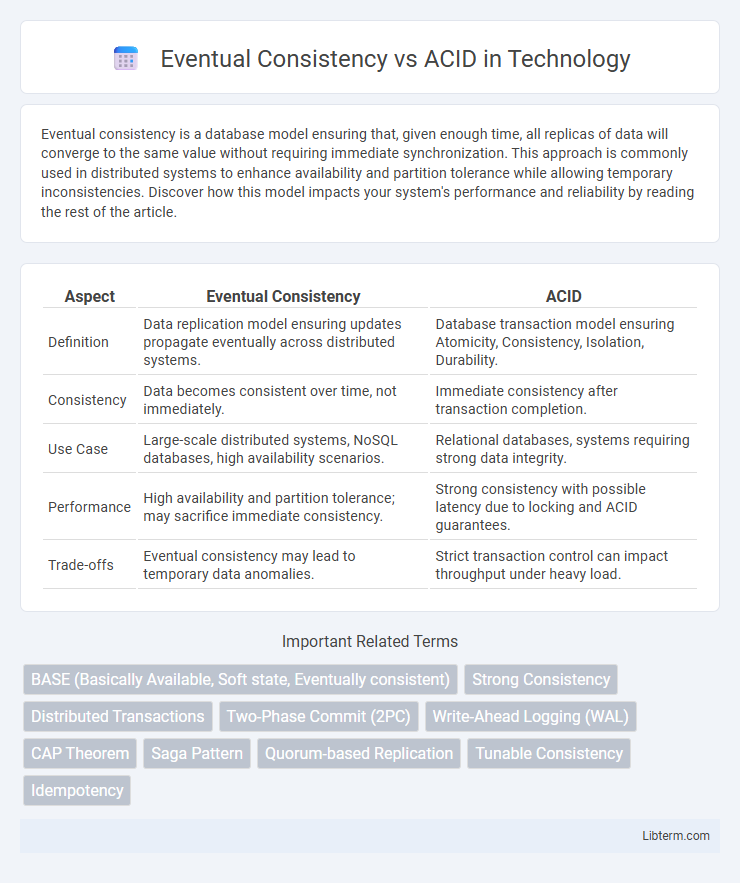Eventual consistency is a database model ensuring that, given enough time, all replicas of data will converge to the same value without requiring immediate synchronization. This approach is commonly used in distributed systems to enhance availability and partition tolerance while allowing temporary inconsistencies. Discover how this model impacts your system's performance and reliability by reading the rest of the article.
Table of Comparison
| Aspect | Eventual Consistency | ACID |
|---|---|---|
| Definition | Data replication model ensuring updates propagate eventually across distributed systems. | Database transaction model ensuring Atomicity, Consistency, Isolation, Durability. |
| Consistency | Data becomes consistent over time, not immediately. | Immediate consistency after transaction completion. |
| Use Case | Large-scale distributed systems, NoSQL databases, high availability scenarios. | Relational databases, systems requiring strong data integrity. |
| Performance | High availability and partition tolerance; may sacrifice immediate consistency. | Strong consistency with possible latency due to locking and ACID guarantees. |
| Trade-offs | Eventual consistency may lead to temporary data anomalies. | Strict transaction control can impact throughput under heavy load. |
Introduction to Data Consistency Models
Eventual consistency and ACID represent two fundamental data consistency models catering to different system requirements and trade-offs between availability and reliability. ACID (Atomicity, Consistency, Isolation, Durability) ensures strict correctness and transaction reliability in relational databases, ideal for financial and critical business systems. Eventual consistency, commonly used in distributed NoSQL databases, sacrifices immediate consistency for higher availability and partition tolerance, guaranteeing that all replicas converge to the same state over time.
What is Eventual Consistency?
Eventual Consistency is a consistency model used in distributed databases where updates to a data item propagate asynchronously, allowing temporary inconsistencies but guaranteeing that all replicas converge to the same value over time. Unlike ACID (Atomicity, Consistency, Isolation, Durability) transactions that enforce strict consistency at each operation, Eventual Consistency prioritizes availability and partition tolerance in distributed systems by enabling immediate responses with updates being synchronized in the background. This model is essential for large-scale applications like cloud storage and NoSQL databases where system scalability and fault tolerance outweigh immediate consistency requirements.
Understanding ACID Properties
ACID properties--Atomicity, Consistency, Isolation, and Durability--ensure reliable transaction processing in traditional database systems by guaranteeing complete success or failure, maintaining database integrity, preventing concurrent transaction interference, and safeguarding data against system failures. These properties are fundamental for applications requiring strict correctness and predictable outcomes, such as financial systems and inventory management. Understanding ACID helps clarify why eventual consistency models prioritize availability and partition tolerance over immediate consistency in distributed environments.
Key Differences: Eventual Consistency vs ACID
Eventual consistency ensures data replication across distributed systems, allowing temporary inconsistencies that resolve over time, prioritizing availability and partition tolerance. ACID (Atomicity, Consistency, Isolation, Durability) guarantees immediate data integrity and reliability in transactional systems, focusing on strong consistency and isolation. The key difference lies in ACID's strict consistency model versus eventual consistency's tolerance for latency in synchronization to achieve scalability.
Use Cases for Eventual Consistency
Eventual consistency is ideal for distributed systems requiring high availability and horizontal scaling, such as social media platforms or e-commerce sites where user actions like posting or purchasing can tolerate brief data latency. Use cases include global caching, content delivery networks, and IoT applications where system responsiveness outweighs immediate consistency. This model supports partition tolerance and enables systems to remain operational during network partitions, unlike strict ACID compliance, which prioritizes transaction atomicity and immediate consistency but can sacrifice availability in distributed environments.
Use Cases for ACID Transactions
ACID transactions are essential for use cases requiring strict data integrity, such as financial systems, inventory management, and booking platforms where consistency and atomicity guarantee accurate and reliable operations. These transactions ensure that all database changes within a transaction are fully committed or rolled back, maintaining data accuracy during concurrent updates and system failures. Complex applications involving payment processing, order fulfillment, and user authentication benefit from the robust consistency and isolation properties provided by ACID compliance.
Performance and Scalability Considerations
Eventual consistency allows distributed databases to achieve higher performance and scalability by relaxing immediate data synchronization, enabling faster write operations and improved availability across multiple nodes. ACID compliance ensures strong consistency and data integrity through strict transaction control, but often results in higher latency and limited scalability due to synchronous locking and coordination overhead. Choosing between eventual consistency and ACID depends on application requirements for real-time accuracy versus system throughput and distributed scalability.
Data Integrity and Reliability Implications
Eventual consistency prioritizes system availability and partition tolerance, allowing temporary data discrepancies that resolve over time, which can impact immediate data integrity but supports high scalability and fault tolerance. ACID properties enforce strict atomicity, consistency, isolation, and durability, ensuring data reliability and integrity through transactional guarantees but often at the cost of system performance and availability under distributed conditions. Systems requiring strong data correctness and transactional accuracy prefer ACID, while those favoring responsiveness and partition resilience often adopt eventual consistency models.
Choosing the Right Model for Your Application
Choosing between Eventual Consistency and ACID depends on application requirements for data accuracy, latency, and fault tolerance. ACID guarantees strong consistency with atomic transactions, essential for financial and critical systems where data integrity is paramount. Eventual Consistency suits distributed systems prioritizing availability and partition tolerance, enabling higher scalability and responsiveness in applications like social media or caching services.
Future Trends in Database Consistency Models
Future trends in database consistency models emphasize hybrid approaches combining the strong guarantees of ACID (Atomicity, Consistency, Isolation, Durability) with the scalability and high availability of eventual consistency. Advances in distributed systems leverage machine learning to dynamically adjust consistency levels based on workload patterns and application requirements. Innovations in multi-model databases and blockchain integration further push towards flexible consistency models that optimize for latency, fault tolerance, and data integrity in complex environments.
Eventual Consistency Infographic

 libterm.com
libterm.com